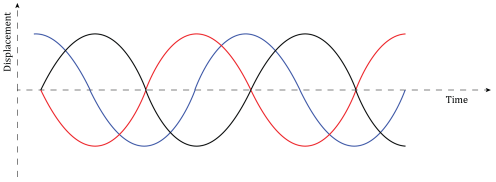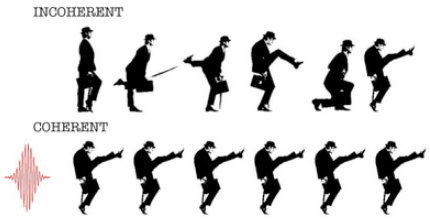Objectives:
- To understand the principle of superposition of waves
- Identify techniques and procedures used for superposition experiments using sound, light and microwaves
- To understand and interpret graphical methods used to illustrate the principle of superposition
- To understand the terms Interference, coherence, path difference and phase difference
- To be able to understand the terms constructive interference and destructive interference in terms of path difference and phase difference
Interference is a phenomenon that is really important, as it occurs all around us. It can cause sound to be louder in certain points and quieter in other, depending whether constructive or destructive interference occurs.
Interference
Interference is when two or more waves interact with each other to distort the waveform of others.
An Interference phenomenon occurs when two waves have a path difference to reach the same point. At this stage, these waves will reach that point out of phase, with a phase difference.
Path difference
The path difference is the difference in path length for two waves to reach the same point.
When two coherent waves have some phase difference, it means that they are a fraction of cycle ahead or behind each other.
Phase difference
Phase difference is when two waves are not coherent and have elapsed and represents the amount by which they are out of phase with each other. It is the fraction of the wave cycle that has elapsed relative to the origin.
The phase difference is the fraction of a complete cycle or oscillation between two oscillating points, expressed in degrees or radians. The phase difference can be calculated by simply using fractional parts of wavelengths or period.
You can clearly see they all have the same frequency and wavelength, they are coherent (we’ll talk about coherence later), but they don’t overlap. If we consider the black line to be one wave, we can say that the the red wave is out of phase or
radians or half a cycle. We can also say that the blue one is
out of phase with the black one and with the red one as well.
Waves are said to be coherent when their relative phase difference remains constant over the period of observation and they have the same frequency.
Coherence is really important for experiments such as the ones described later on. Two waves can be coherent even if they don’t exactly overlap. As long as their phase difference is constant and they have the same waveform.
Coming back to the interference and diffraction topic, when two waves meet, no matter whether they are coherent or not, they interact and superpose.
Superposition
The principle of superposition states that when two waves meet, the total displacement at a point is equal to the sum of the individual displacements at that point.
There are although some condition that waves need to respect to interfere:
- Waves must be of similar types, so they won’t interfere if one is transverse and the other is longitudinal;
- The wave sources most maintain a constant phase relation with one another, they must be coherent;
- Superposition will occur whether waves are coherent or not they will just form a fixed pattern if they are.
Constructive and destructive interference
When two waves meet, they interfere and they superpose. There are two special cases, where the two waves have the same frequency and are coherent. When they interfere they can have a constructive interference and a destructive interference.
Constructive interference occurs when the two waves superpose at the right time to give the maximum superposition, while destructive interference the minimum.
If you look at the figure above, the constructive interference occurs when the lines of the two diffracted waves meet and there is a cross of lines. There the constructive interference occurs, as the superposition occurs when both waves are at maximum peak. The destructive interference occurs when the line of one wave is exactly half way between two lines of the other wave.
 Page co-written by Luca Quinci – Thank you!
Page co-written by Luca Quinci – Thank you!
Further reading:
- Isaac Physics – Superposition – This is a reading resource
- Research practical applications of wave interference.
- The Rise of the Wave Theory of Light: Optical Theory and Experiment in the Early Nineteenth Century by Jed Z. Buchwald – preview




You must be logged in to post a comment.